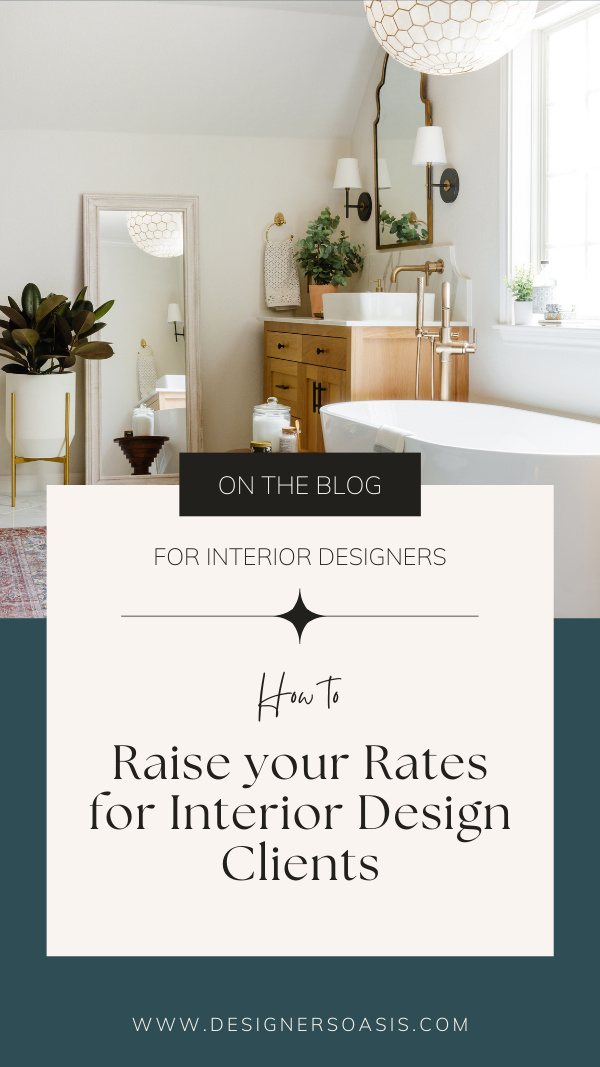How to Raise your Rates for Interior Design Clients
As the new year will quickly approach, you may be thinking about raising your design fees. However, you may also be struggling with how to convey this message to your interior design clients. The way you communicate with your clients says a lot about you and your business, so it’s important to share this update in a thoughtful manner.
It’s pretty common to raise your rates annually, especially in the early years. You wouldn’t want to announce rate increases to the same clients more than once a year.
CONSIDER A GRADUAL INCREASE
Let’s say you are currently charging $85/hr and you want to get to $120/hr. That’s a significant 35% increase. Perhaps, it would be best to start any new clients at your goal rate of $120/hr, but increase your existing clients from $85 to $100/hr this year - a more palpable 15% increase.
NOT ALL CLIENTS HAVE TO BE AT THE SAME RATE
As mentioned above, you may decide to keep existing clients at your current rate, and simply start new clients at your desired rate. This eliminates any need for a fee increase announcement. It makes a lot of sense for existing clients who may be closing out a project with you in the next few months. Furthermore, you certainly wouldn’t want to send a brand new client a fee increase just as you are getting started.
DON’T BE AFRAID OF LOSING CLIENTS
You may find that once you announce the changes to your design fees, some clients may want to expedite closing out a project with you. Instead of fearing this result, look at it as a way to make space for higher-valued clients who are eager to work with you.
HOW TO TELL YOUR CLIENTS YOU ARE RAISING YOUR DESIGN FEES
Don’t over-explain - The breadth of your explanation should match the price increase. In other words, a 5% increase needs only a brief explanation whereas a 20% increase should provide more context and more value-added services.
#1 Value Add for your Clients - Need a simple explanation to tell your clients? Raising your rates will allow you to take on fewer clients, so you can provide more attention to the ones you are working with.
Shine a Light on your Accomplishments - If you have completed any kind of additional training or education, share that new knowledge with your clients. They will see this as an added benefit as your client.
Create a Fee Ladder - Perhaps you’ve hired a design assistant (or similar role) to help you implement the design process. As long as they are working on the project and billable, it’s worth sharing their hourly rate with your client. It is presumably lower than your hourly rate, which may result in no measurable increase for your clients. Yet they still get the same results.
Give plenty of notice - Do not spring a fee increase on your clients and certainly don’t send an invoice with the change without a conversation first. 90 days is best, 60 days works, 30 okay, but not ideal. Set a clear start date that you share with them such as (i.e. The new fee structure will take effect on March 1, 2022.) Give them a courtesy reminder before the date you’ve set.
WHAT SHOULD YOU CHARGE?
Design fees are nuanced. Several factors influence what you should charge such as your level of education, years of experience, certifications, and the region you serve.
Additionally, you likely charge a premium for services like Design Only, eDesign, Designer for a Day, or Consultations whenever you’re not making a commission on orders.
I can’t tell you in a blog post exactly how much you should charge, but I do have a few quick thoughts on the subject. I’ve been doing this long enough to know that there is a good chance you are undercharging for your services. I’d encourage you to raise your rates to slightly above your comfort level.
I’d start by doing some research. Don’t be afraid to ask a trusted colleague or a design mentor in your area. ASID publishes white papers on this topic that they sell if you want to go deep on the subject.




